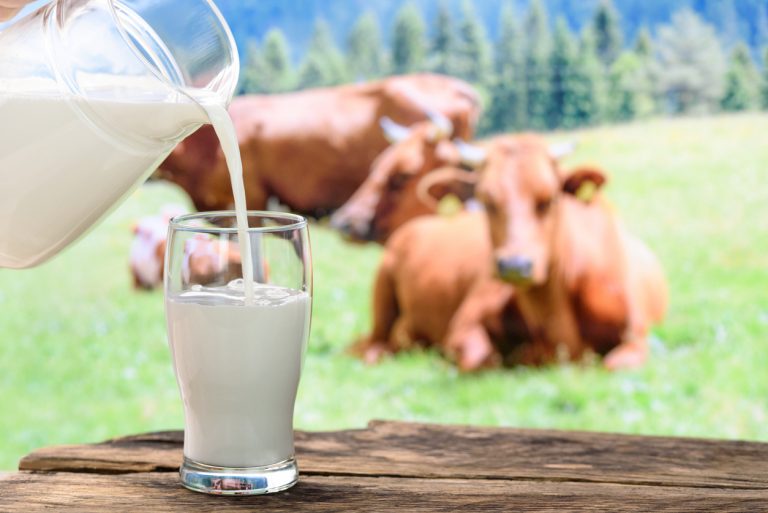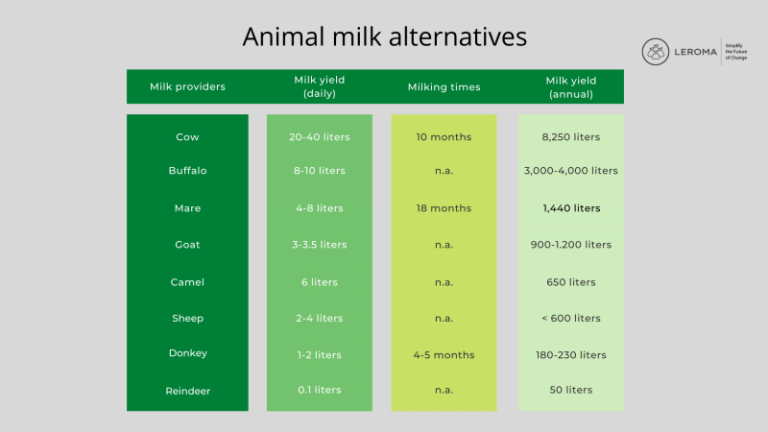In addition, the milking process is much more difficult with some animals than with cows. With camels, for example, the foal must first suck milk briefly before milking can begin. The foal stands next to its mother during the entire milking process and then drinks the remaining milk.
With reindeer, there is a more fundamental problem. They are difficult to approach during the calf rearing period because they defend their young against any approach.
Moreover, especially in recent years, global warming is a challenge in milk production, affecting all animal milk suppliers, including cows. In addition to humans, animals also suffer from the heat and if they are not comfortable or stressed, they give less or no milk. In addition, there is a shortage of important feedstuffs as the drought leads to crop losses. The purchase of feed therefore increases significantly and thus also influences the cost of milk production. If we consider the different milk yields of the animals and possible difficulties in the milking process, it becomes clear that the production of some alternatives involves more effort at the industry level.
Above all, availability means that consumers who want to buy an animal alternative to cow’s milk also have to put up with significantly higher prices. For example, buffalo milk currently costs more than five times as much as cow’s milk and donkey milk even 30 times as much. These prices reduce the competitiveness of the alternatives and lead to the fact that the substitute products do not become goods of daily use. In addition, some products are currently only available online.
In Austria, sheep milk production increased by 11% between 2013 and 2019, reaching 12,186 tons. The production of goat milk increased by 29% in the same period, reaching 26,521 tons in 2019. In the same year, 3,781.337 tons of cow milk were produced. This represents a growth of 11.5%. Although these numbers show that the production of animal milk alternatives is increasing, cow’s milk is still far ahead.
This is neither due to higher prices nor to lack of interest, because although there are no exact figures on the other “exotics” on the market, we see that they are gaining more and more presence in this country. In fact, there is a surplus demand that cannot yet be met due to low availability. Therefore, animal milk alternatives will probably remain more of a luxury food in the future that cannot be consumed in the same quantities as cow’s milk.
In the following, we would nevertheless like to introduce you to the individual milk alternatives and their specific properties in a little more detail:
Goat milk is obtained from many different breeds of goats and can be processed and consumed pasteurized or raw, although raw milk is best enjoyed fresh.
It has a fine, creamy consistency and white color, as well as a slightly sweet, spicy and sour aroma. However, the taste of goat’s milk is often perceived as very harsh, because it quickly absorbs foreign odors. Experience shows that close cooperation with farmers is important in order to ensure the continued quality of the products. Proper handling of milk has a major impact on the quality of the final product, such as the undesirable strong goat odor or taste. For example, fast processing and modern hygiene standards directly on the farm can prevent the absorption of goat or barn odor and thus soften the strong taste.
Goat milk is currently used mainly for cheese production. The fine sour goat cheese has been trendy for a long time and the demand is increasing. There are many different types such as Camembert, semi-hard, hard and fresh cheeses, which have a delicate, creamy texture and can taste both mild and strong-aromatic. In addition, there are cheeses made from raw milk, for example, by French producers who want to avoid flavor loss by processing the milk further. This variant must be labeled as raw milk cheese. In addition to cheese, goat’s milk is also suitable for butter and yoghurts. The yoghurt quickly becomes very liquid and can be boiled down or thickened with goat’s milk powder, for example. Manufacturers who use the milk powder instead of pure milk as a base from the beginning can increase the dry matter or add less water. Both the powder and the milk can also be used for baking and cooking just like cow’s milk. The powder is also widely used as a substitute for baby milk, as goat milk is particularly well tolerated because it contains fewer long-chain lactic acids. Besides, it is not only used in the food industry, but also in care products such as soap and shampoo.
Sheep’s milk is characterized by its naturally sweet taste with a slight almond flavor. It has a creamy consistency and is mainly sold pasteurized and processed into various end products. Because of its high protein content, which is almost double that of cow’s milk, it easily achieves a nice, firm and creamy consistency in yoghurt and butter production. However, consumers often reject the butter at first because its white color is different from the yellowish cow’s milk butter. On the other hand, sheep’s milk cheese, for example cream cheese or soft cheese, into which sheep’s milk is mainly processed, enjoys great popularity. In the production of soft cheese, water must be added to the milk to bring the protein content into line with that of cow’s milk. Sheep’s milk cheese can then be used to make feta cheese, which is probably the best-known product made from sheep’s milk. But only if it is ripened in brine and comes from Greece, it can really call itself “Feta”. Like goat’s milk, sheep’s milk is also available as a powder and is used in care products.
Buffalo milk is obtained from the water buffalo, which is hardly susceptible to disease and thus has an average life expectancy of 25 years, during which it can also serve as a milk supplier. Dairy cows, on the other hand, are sorted out for slaughter after only four or five years, as they become ill more quickly and veterinary treatment is not worthwhile due to the low milk prices.
Probably the best-known product made from buffalo milk is buffalo mozzarella. Anyone who has tried it knows the intense nutty flavor, which is suitable for savory products such as cottage cheese, but hardly if at all for desserts. Buffalo mozzarella is softer than the conventional mozzarella made from cow’s milk, which, on the other hand, is somewhat rubbery. Buffalo milk can also be used for baking and is often available as a powder. In addition, it is an ingredient in masks, bath additives and creams, which are said to help regulate wrinkles in particular.
Mare’s milk tastes sweet and slightly nutty and is extremely sensitive in its raw state and therefore rapidly perishable, which is why it is usually powdered directly or frozen for sale. The powder can be used for baking or stirred into yogurts and puddings, among other uses. However, mare’s milk is mainly found in the health sector, in the form of creams and tablets. These tablets are sold in pharmacies and also in online stores and are said to have a soothing effect, especially on skin diseases.
While sheep, goat and buffalo milk and their products are now very familiar to us, the normal consumer probably associates donkey and camel milk more with the cosmetics industry. We now take a brief look at these two substitutes for cow’s milk, which are also very suitable for consumption:
Camel milk is obtained from Bactrian camels and dromedaries, has a slightly salty aftertaste and is mainly offered in online shops, mostly as powder. There you can also find camel milk chocolate, and although camel milk does not coagulate, there is also camel milk cheese, for which the milk is artificially coagulated. In the cosmetics industry, the milk is used mainly for soaps and creams, because it contains lanolin and elastin, which are good for the skin.
Donkey milk is milked exclusively by hand and has long been used in the cosmetics industry for soap, shampoo and creams because of its high skin compatibility. But it is also very suitable for consumption, because it contains many vitamins and nutrients. Because of its composition, which is similar to human breast milk, it even forms an alternative for babies who cannot be breastfed and are allergic to cow’s milk.
The animal milk alternatives listed here are versatile and a welcome change not only for allergy sufferers. Food manufacturers can follow these milk trends to differentiate themselves from the competition and generate alternative products.
Raw materials for the production of milk and milk products can of course also be found on the platform of LEROMA.
Let‘s simplify the future of change!



